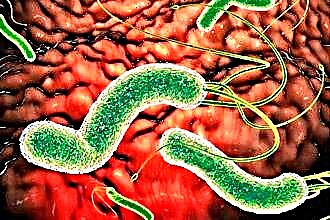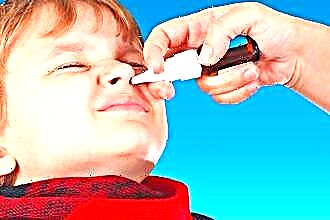Signs
 Hypertrophic (hyperplastic) laryngitis is characterized by the following symptoms that are typical for any laryngitis:
Hypertrophic (hyperplastic) laryngitis is characterized by the following symptoms that are typical for any laryngitis:
- sore throat and scratching;
- dry cough;
- a qualitative change in voice.
Various forms of laryngitis can be clarified when conducting an objective examination of the larynx, laryngoscopy. The disease can develop with diffuse or local lesions of the mucous membrane.
Visual examination reveals these characteristic features that distinguish each form of laryngitis.
Diffuse lesion is characterized by thickening and swelling of the laryngeal mucosa throughout. This process also affects the vocal cords. They look thickened along the edge, which prevents them from closing, and, therefore, contributes to a change in the timbre of the voice, the appearance of its hoarseness.
With a limited form, not the entire larynx is affected as a whole, but its separate area. Usually the vocal cords are affected by the pathological process. The lesion is manifested by the presence of epithelial growths, which are represented by nodules on a thick leg, about 2 mm in diameter. These nodules also prevent the ligaments from closing and lead to the development of the characteristic trait.
For the rest of the length, the mucous membrane is not changed. It retains its pale pink color. However, the exacerbation of the process is characterized by changes in the laryngeal mucosa. She becomes hyperemic and edematous.
In some cases, there may be a predominant lesion of the subglottic region. Nodular growths in this, the narrowest, place of the larynx lead to an aggravation of symptoms due to difficulty in the passage of air through the respiratory tract. In this case, there will be stridorous noisy breathing, shortness of breath.
Differential diagnosis
The main reason for the development of this form of laryngitis, especially its local form, is the overstrain of the vocal cords, due to the patient's professional activities. Systematic prolonged and loud recitation, singing, screaming are accompanied by the work of the vocal cords with increased stress, which leads to the development of this pathology. Finding out the nature of professional activity, a specialist may suspect a disease already at the stage of studying complaints and collecting an anamnesis of life.
It is possible to reliably diagnose chronic hypertrophic laryngitis only with direct laryngoscopy, since an indirect examination of the larynx does not allow a full study of its lower parts.
This form of the disease requires differential diagnosis with laryngitis caused by exposure to nonspecific pathogens, tuberculosis or syphilitic. In all unclear cases, a dubious nodule can be removed during the study for further histological examination. Biopsy is a reliable diagnostic method that can reliably determine the nature of the lesion.
Laryngitis due to specific pathogens is not a primary disease. Usually, in the larynx, the pathological process develops by spreading it from the lungs, as in tuberculosis, or systemic damage, as in secondary syphilis. Of great importance in differential diagnosis is also the anamnesis of the disease and life, which makes it possible to identify the pathology that caused the development of inflammation in the larynx. Laboratory diagnostics also plays an irreplaceable role in the diagnosis of specific infectious processes.
In favor of a nonspecific inflammatory process in the larynx is evidenced by such a sign as the symmetry of the lesion.
The nodules are usually located on both sides of the laryngeal mucosa. Tuberculosis or lesion of the larynx with syphilis is characterized by single pathological foci located chaotically.
Chronic hyperplastic laryngitis has to be differentiated with a malignant tumor process in the larynx, characterized by the development of tuberosity. The presence of a prolonged dry cough, the appearance of hoarseness is the reason for a thorough examination of the larynx. The biopsy should be an integral part of it. A limited hyperplastic area of the mucous membrane can be regarded as a precancerous condition. Timely endolaryngeal removal of the pathological site increases the chances of a successful outcome.
Treatment principles
Treatment of chronic laryngitis differs during exacerbation and remission. Outside of exacerbation, patients are worried about a constantly hoarse voice, its rapid fatigue. There is a worsening of the condition at the end of the day. In some cases, aphonia may be noted in the evening, that is, the voice loses its sonority, maintaining a whispering speech. Disturbed by periodic coughing. Treatment for such patients consists of the appointment of voice rest. If necessary, it is indicated to carry out procedures that have a softening, analgesic effect on the laryngeal mucosa.
The period of remission is a good time to decide on a surgical method of treatment. To remove epithelial growths, cauterization with lapis, a solution of silver nitrate, can be used. To obtain the desired effect, such spotting is carried out regularly for two weeks. In a severe case, radio wave removal of nodules can be applied, carried out with anesthesia with the direct participation of endoscopic techniques.
Treatment of hypertrophic laryngitis in the acute period includes the following areas:
- plentiful warm alkaline drink;
- gargling with soda solution, decoction of herbs;
- local use of drugs with analgesic, anti-inflammatory action;
- use of cough medicines;
- with a long and severe course of the disease, the use of antibiotics.
As means of local treatment, drugs are used in the form of aerosols, lozenges, tablets, Faringosept, Septolete, Tandum Verde, Decatilen, which have anti-inflammatory and analgesic effects. However, according to experts, their effectiveness is insignificant, and therefore, the funds can be used only with a mild course of the disease.
The effect can be achieved when carrying out alkaline inhalations, or using decoctions of herbs that have anti-inflammatory and expectorant properties, coltsfoot, thyme, calendula, chamomile, sage. For the treatment of cough, mucolytic agents, ACC, Bromhexin, Ambroxol, drugs with an expectorant effect, such as marshmallow root, plantain, are also used. With a dry hacking cough, antitussives are used, the most effective of which are drugs based on codeine.
Traditional medicine has been widely used in the treatment of hyperplastic inflammation of the larynx.It is believed that gargling with a decoction of celandine herb, which has an antitumor effect, can help reduce hypertrophic growths and improve the condition.
However, experts advise turning to this method only after the surgical intervention, without replacing it.
Prevention
Treatment of any form of laryngitis must necessarily include preventive action. They are as follows:
- patients prone to the development of this pathology of the ENT organs are not recommended to eat or drink too hot or cold dishes;
- the patient's stay in ecologically unfavorable places should be limited;
- inhalation of hot dry air is also an unfavorable factor;
- shown sanatorium treatment in the forest zone, on the shore of the reservoir;
- patients prone to developing inflammation of the larynx should not be in conditions of gas pollution or exposure to other chemically hazardous substances;
- exclusion of active or passive smoking, as well as abuse of strong alcoholic beverages;
- increasing the patient's immunity, which consists in the use of immunostimulating drugs, as well as the rehabilitation of concomitant foci of infection and hardening.



